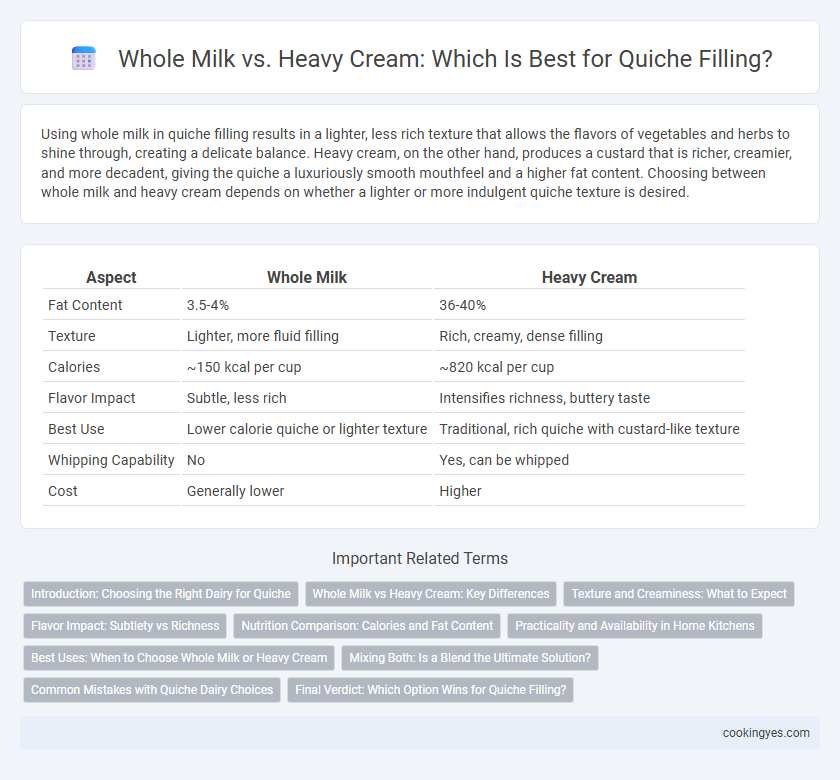Using whole milk in quiche filling results in a lighter, less rich texture that allows the flavors of vegetables and herbs to shine through, creating a delicate balance. Heavy cream, on the other hand, produces a custard that is richer, creamier, and more decadent, giving the quiche a luxuriously smooth mouthfeel and a higher fat content. Choosing between whole milk and heavy cream depends on whether a lighter or more indulgent quiche texture is desired.
Table of Comparison
| Aspect | Whole Milk | Heavy Cream |
|---|---|---|
| Fat Content | 3.5-4% | 36-40% |
| Texture | Lighter, more fluid filling | Rich, creamy, dense filling |
| Calories | ~150 kcal per cup | ~820 kcal per cup |
| Flavor Impact | Subtle, less rich | Intensifies richness, buttery taste |
| Best Use | Lower calorie quiche or lighter texture | Traditional, rich quiche with custard-like texture |
| Whipping Capability | No | Yes, can be whipped |
| Cost | Generally lower | Higher |
Introduction: Choosing the Right Dairy for Quiche
Whole milk provides a lighter, creamier texture to quiche filling with about 3.25% fat content, resulting in a delicate and less rich custard. Heavy cream, containing approximately 36% fat, yields a richer, denser, and more indulgent quiche custard with a velvety mouthfeel. Selecting whole milk or heavy cream directly influences the quiche's consistency and richness, catering to desired taste and dietary preferences.
Whole Milk vs Heavy Cream: Key Differences
Whole milk and heavy cream significantly impact quiche filling's texture and richness. Whole milk yields a lighter, more custard-like consistency with fewer calories, while heavy cream creates a denser, creamier, and richer quiche due to its higher fat content. Choosing between the two affects both the mouthfeel and calorie density, with heavy cream delivering a more indulgent flavor profile.
Texture and Creaminess: What to Expect
Whole milk produces a lighter, less dense quiche filling with a subtle creaminess, ideal for those seeking a delicate texture. Heavy cream yields a richer, silkier custard with a velvety mouthfeel and enhanced moisture retention, resulting in a more decadent quiche. Using a combination of both can balance creaminess and firmness, optimizing texture without overpowering the eggs.
Flavor Impact: Subtlety vs Richness
Using whole milk in quiche filling delivers a subtle, creamy flavor that allows the eggs and fillings to shine without overpowering. Heavy cream adds a luxurious richness and velvety texture, intensifying the overall taste and creating a more indulgent experience. Choosing whole milk emphasizes lightness and balance, while heavy cream enhances decadence and depth of flavor.
Nutrition Comparison: Calories and Fat Content
Whole milk contains approximately 150 calories and 8 grams of fat per cup, making it a lighter option for quiche filling compared to heavy cream, which has about 820 calories and 88 grams of fat per cup. The higher fat content in heavy cream contributes to a richer, creamier texture and increased calorie density in the final dish. Choosing whole milk can reduce overall calorie and fat intake while maintaining adequate moisture and flavor in quiche recipes.
Practicality and Availability in Home Kitchens
Whole milk offers a lighter texture and is more commonly found in home kitchens, making it a practical choice for quiche filling. Heavy cream provides a richer, creamier consistency but may not be as readily available or preferred for everyday cooking. Using whole milk balances accessibility with a smooth, tender quiche custard suitable for most household ingredients.
Best Uses: When to Choose Whole Milk or Heavy Cream
Whole milk is ideal for a lighter, less rich quiche filling, providing a smooth texture without overwhelming the other ingredients. Heavy cream is best when a richer, creamier consistency is desired, enhancing flavor depth and creating a custard-like texture. Choose whole milk for healthier, delicate quiches and heavy cream for indulgent, decadent quiches that require a thicker, silkier filling.
Mixing Both: Is a Blend the Ultimate Solution?
Blending whole milk and heavy cream for quiche filling strikes an ideal balance between richness and texture, combining the creaminess of heavy cream with the lightness of whole milk. This mixture enhances custard consistency, preventing an overly dense or runny filling while delivering a smooth, velvety mouthfeel. Culinary tests reveal that a 50/50 ratio optimizes moisture retention and flavor depth, resulting in a perfectly set quiche with a tender bite.
Common Mistakes with Quiche Dairy Choices
Using whole milk instead of heavy cream in quiche filling often results in a less creamy texture and a runnier consistency due to the lower fat content in whole milk (about 3.25%) compared to heavy cream (around 36-40%). Common mistakes include underestimating the importance of fat, which helps achieve the rich, custard-like structure essential to traditional quiche. Choosing heavy cream or a mixture of cream and milk ensures a balanced texture and prevents a watery filling or an overly dense quiche.
Final Verdict: Which Option Wins for Quiche Filling?
Heavy cream creates a richer, silkier quiche filling with a higher fat content that enhances texture and flavor, making it ideal for a custard-like consistency. Whole milk results in a lighter, less dense filling with approximately 3.5% fat, providing a more delicate taste but less creaminess. For the perfect balance of richness and smoothness, heavy cream typically wins as the preferred choice in quiche filling recipes.
Whole milk vs heavy cream for quiche filling Infographic

 cookingyes.com
cookingyes.com